Podcast: Play in new window | Download
Subscribe: Apple Podcasts | RSS
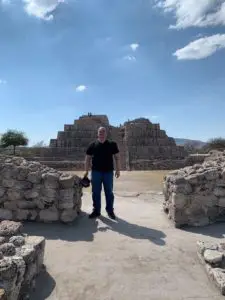 I’m going to depart from my normal way of presenting things and go a little more personal in this episode. On February 19, 2020 I took a buying trip for my business to the wonderful state of Guanajuato in central Mexico. My base was San Miguel de Allende, the charming colonial town that seems at times completely overrun by American expats. Buying trips can be grueling sometimes, especially if you are sick with a cold, like I was. I took Saturday to rest up a bit, but after a few hours of being cooped up in my hotel room I decided that I wanted to be out and about, perhaps play tourist, and do some sort of easy prepackaged English language day excursion on an air-conditioned bus that would hit the highlights of San Miguel de Allende. I’m not a packaged-tour kind of guy but decided I would do this on my “easy” day. I talked to the young woman at the front desk of my little hotel and told her what I wanted. She asked me if I would be interested in taking a tour of San Miguel with a side trip to the ruins outside of town. “¿Ruinas?” I said, puzzled. I didn’t know that there were ruins nearby. Even though a side trip would add a few hours to the tour, I said, “Yes.” The front desk woman told me to be ready to be picked up at noon. When I showed up at twelve o’clock, I was met by a young and eager tour guide named Joel and he was going to take me around for the rest of the day. Where was the bus? No bus. Do you speak English? No English. Where are the others? It was just me. So, I hopped in Joel’s car and we began the tour. He looked at me and told me that I probably needed a hat and that even though I didn’t bring water, he brought some for me, because after a brief stop at the museum and visitors center we would be traveling by van along two miles of lumpy roads and then we would be hiking in the hot sun for about an hour to get up to the ruins. Joel was kind enough to let me borrow his hat. Mil gracias, or a thousand thanks, for that small but vital gesture. I had no idea what I was getting myself into.
I’m going to depart from my normal way of presenting things and go a little more personal in this episode. On February 19, 2020 I took a buying trip for my business to the wonderful state of Guanajuato in central Mexico. My base was San Miguel de Allende, the charming colonial town that seems at times completely overrun by American expats. Buying trips can be grueling sometimes, especially if you are sick with a cold, like I was. I took Saturday to rest up a bit, but after a few hours of being cooped up in my hotel room I decided that I wanted to be out and about, perhaps play tourist, and do some sort of easy prepackaged English language day excursion on an air-conditioned bus that would hit the highlights of San Miguel de Allende. I’m not a packaged-tour kind of guy but decided I would do this on my “easy” day. I talked to the young woman at the front desk of my little hotel and told her what I wanted. She asked me if I would be interested in taking a tour of San Miguel with a side trip to the ruins outside of town. “¿Ruinas?” I said, puzzled. I didn’t know that there were ruins nearby. Even though a side trip would add a few hours to the tour, I said, “Yes.” The front desk woman told me to be ready to be picked up at noon. When I showed up at twelve o’clock, I was met by a young and eager tour guide named Joel and he was going to take me around for the rest of the day. Where was the bus? No bus. Do you speak English? No English. Where are the others? It was just me. So, I hopped in Joel’s car and we began the tour. He looked at me and told me that I probably needed a hat and that even though I didn’t bring water, he brought some for me, because after a brief stop at the museum and visitors center we would be traveling by van along two miles of lumpy roads and then we would be hiking in the hot sun for about an hour to get up to the ruins. Joel was kind enough to let me borrow his hat. Mil gracias, or a thousand thanks, for that small but vital gesture. I had no idea what I was getting myself into.
The Spanish called this “lost city” Cañada de la Virgen, or, “The Ravine of the Virgin,” owing to a geographical feature of the same name nearby. In my thirty-plus years studying the ancient cultures of Mexico and the cities they left behind, Cañada de la Virgen never once appeared on my radar. Why not? It seems like it’s a pretty well-kept secret, even though, as I would find out myself, it may be one of the most important sites in all of ancient Mexico. Serious excavations and formal scientific studies are fairly recent here. The first official excavation began at Cañada in the year 2002 and the National Institute of Anthropology and History out of Mexico City has only granted the public limited access to this site since 2011. For most of the day, the ruins sit quietly behind locked gates secured by heavy chains. An official from the off-site museum with the keys to the gates must accompany all visitors to the ruins proper.
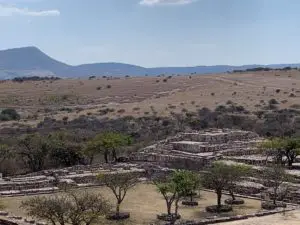 Archaeologists are still trying to piece together the history at Cañada de la Virgen. They generally agree that the site was occupied from the mid 500s AD to about 1050 AD. Some theorize that the city grew with the fall of Teotihuacán and took over some of the ritualistic activities once present in that great city. For more information about Teotihuacán, please see Mexico Unexplained Episode #45: https://mexicounexplained.com//teotihuacan-lost-city-gods/ As with many ancient sites in Mesoamerica, there is a layering apparent at Cañada indicating newer construction on top of older, along with a general expansion over time. No one knows how many successive cultures occupied the site during its history of over 500 years. The latest confirmed inhabitants were the Otomí, whose culture reached its peak of complexity at around 900 AD. Modern-day descendants of these people who speak the Otomí language still live in the region to this day. While the original builders and some of the successive occupants may be somewhat of a mystery, there is no doubt among archaeologists of Cañada’s role in the region: For five centuries it functioned as a religious center drawing thousands of pilgrims annually from all parts of ancient Mexico. Goods from all over Mesoamerica – in time and region – have been unearthed at Cañada. Seashells from both Mexican coasts along with items from as far away as the modern-day American Southwest have been found here.
Archaeologists are still trying to piece together the history at Cañada de la Virgen. They generally agree that the site was occupied from the mid 500s AD to about 1050 AD. Some theorize that the city grew with the fall of Teotihuacán and took over some of the ritualistic activities once present in that great city. For more information about Teotihuacán, please see Mexico Unexplained Episode #45: https://mexicounexplained.com//teotihuacan-lost-city-gods/ As with many ancient sites in Mesoamerica, there is a layering apparent at Cañada indicating newer construction on top of older, along with a general expansion over time. No one knows how many successive cultures occupied the site during its history of over 500 years. The latest confirmed inhabitants were the Otomí, whose culture reached its peak of complexity at around 900 AD. Modern-day descendants of these people who speak the Otomí language still live in the region to this day. While the original builders and some of the successive occupants may be somewhat of a mystery, there is no doubt among archaeologists of Cañada’s role in the region: For five centuries it functioned as a religious center drawing thousands of pilgrims annually from all parts of ancient Mexico. Goods from all over Mesoamerica – in time and region – have been unearthed at Cañada. Seashells from both Mexican coasts along with items from as far away as the modern-day American Southwest have been found here.
After we hiked up to the locked fence, the caretaker from the visitor’s center let a family from Mexico City, my guide Joel and me onto the grounds. The caretaker went with the family and Joel gave me his undivided attention as we walked around the perimeter of the large civic-ceremonial heart of the city. We first went to the northern fringe of the ruins where there used to be a miniature lake. The lake served many purposes, but its most important function was to provide life-giving water to the inhabitants, pilgrims and crops. Archaeologists theorized that when the small lake started to dry up the site became harder to maintain. A region-wide drought, combined with raids from marauding Chichimeca tribes from the north, may have been the double whammy that doomed this site. For more information about the nomadic Chichimec people, please see Mexico Unexplained episode number 142: https://mexicounexplained.com//chichimeca-warriors-of-the-north/ Flowing into the lake were small canals in which newborn babies were purified in a sort of baptismal ritual. On our walk from the purification area, Joel took me to a rounded, circular structure dedicated to the Mesoamerican god Ehécatl, the god of wind and one of the aspects of the feathered serpent god Quetzalcoatl. We looped around the main part of the ruins, the huge central pyramid complex always in view, until we got to the structure known today as The House of the Longest Night. Archaeologists uncovered an elite burial of a young girl there and now call her “The Girl of the Rains.” She earned this moniker because during the excavation of her tomb it rained so much that all work had to be halted for weeks. We continued walking around the main central building area and I couldn’t help but feel like I was back home in New Mexico. The dry scrubland sprinkled with prickly pear reminded me of my childhood playing in the desert mesas around Albuquerque. Joel explained that the type of cactus I was seeing, part of the genus opuntia – known collectively in Mexico as nopal – played an import role in the construction of Cañada. The ancients combined juice and fibers from the nopales with calcium to make a mortar used to cement together the stones of the massive buildings all around us.
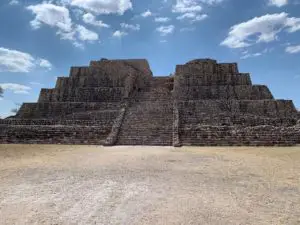 We circled the main complex, the heart of the city, known to archaeologists as the House of the Thirteen Heavens. They call it this because three sides of the structure contain four rooms each. Add these twelve rooms to the room at the top of the pyramid and we have a total of thirteen. Thirteen is the number of moons during a solar year, and the moon played an important role at Cañada de la Virgen, both in ritual and for agriculture. We approached the site’s center from the east and ascended a narrow row of stairs. Below us from the top of the stairs was a massive courtyard or plaza in front of the main pyramid. The top of the pyramid has a space between two temple rooms on top. The sun is perfectly aligned in this space from our vantage point on March 4th of each year. The next full moon after March 4th appears in the exact same spot. This most likely served as a time marker for the planting of crops. The courtyard before us was flanked by rows of stone bleachers on either side where spectators would sit and witness the religious rituals performed in the central courtyard. My guide Joel explained to me that on either side from where we stood at the top of the staircase, announcers would stand to make royal proclamations or to inform the public of upcoming events. Before we descended into the main plaza Joel told me that he always said a prayer and asked permission of the spirits and ancestors to enter in the native language Otomí. I asked him if he could say the words slowly, so that I could repeat them. I wanted to show this awe-inspiring place the respect it rightfully deserved. I repeated what my guide said with care and almost a sort of reverence, although it was difficult for me. Like everything connected with this show, I try my best and my heart is always in the right place. After I got back home to San Diego, I asked Joel to send me a voice recording of this special ancestral permission through WhatsApp, to be included in this show. Here is what Joel asked of the ancestors in Otomí:
We circled the main complex, the heart of the city, known to archaeologists as the House of the Thirteen Heavens. They call it this because three sides of the structure contain four rooms each. Add these twelve rooms to the room at the top of the pyramid and we have a total of thirteen. Thirteen is the number of moons during a solar year, and the moon played an important role at Cañada de la Virgen, both in ritual and for agriculture. We approached the site’s center from the east and ascended a narrow row of stairs. Below us from the top of the stairs was a massive courtyard or plaza in front of the main pyramid. The top of the pyramid has a space between two temple rooms on top. The sun is perfectly aligned in this space from our vantage point on March 4th of each year. The next full moon after March 4th appears in the exact same spot. This most likely served as a time marker for the planting of crops. The courtyard before us was flanked by rows of stone bleachers on either side where spectators would sit and witness the religious rituals performed in the central courtyard. My guide Joel explained to me that on either side from where we stood at the top of the staircase, announcers would stand to make royal proclamations or to inform the public of upcoming events. Before we descended into the main plaza Joel told me that he always said a prayer and asked permission of the spirits and ancestors to enter in the native language Otomí. I asked him if he could say the words slowly, so that I could repeat them. I wanted to show this awe-inspiring place the respect it rightfully deserved. I repeated what my guide said with care and almost a sort of reverence, although it was difficult for me. Like everything connected with this show, I try my best and my heart is always in the right place. After I got back home to San Diego, I asked Joel to send me a voice recording of this special ancestral permission through WhatsApp, to be included in this show. Here is what Joel asked of the ancestors in Otomí:
***Insert voice recording here***
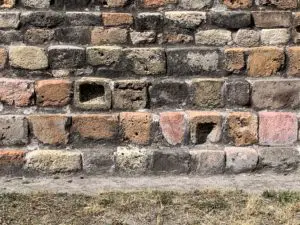 We descended into the plaza and Joel showed me the niches in the side bleachers where people placed votive offerings. To me, they were reminiscent of similar nichos found in Catholic churches reserved for the saints. We crossed the courtyard and ascended another set of steep stairs, these belonging to the pyramid. Before we did, Joel asked me to look at the sides of the staircases. In front of me were two once-elaborate stone representations of feathered serpents running the full length of the stairs. They were very similar to something we see hundreds of miles away at the Temple of Kukulcán in the Maya site of Chichén Itzá which I use as the unofficial logo of Mexico Unexplained. At the top of the pyramid, we encountered the Red Temple. The temple was damaged in the 1940s by someone who used dynamite to blast away stone to try to get to a fabled treasure. He must have been very disappointed to find only pottery and bones. Although subject to other vandalism and looting, most of the walls of the Red Temple are still intact along with a colorful mural on the inside. Although the public is forbidden from entering the temple, the wall painting is still visible from an exterior window. Joel explained that the mural’s lines of color represented the layers of Heaven found in the religious beliefs in the various cultures of ancient Mexico. The different colors used on the walls here were explained by a plaque on the side of the temple. The sign reads:
We descended into the plaza and Joel showed me the niches in the side bleachers where people placed votive offerings. To me, they were reminiscent of similar nichos found in Catholic churches reserved for the saints. We crossed the courtyard and ascended another set of steep stairs, these belonging to the pyramid. Before we did, Joel asked me to look at the sides of the staircases. In front of me were two once-elaborate stone representations of feathered serpents running the full length of the stairs. They were very similar to something we see hundreds of miles away at the Temple of Kukulcán in the Maya site of Chichén Itzá which I use as the unofficial logo of Mexico Unexplained. At the top of the pyramid, we encountered the Red Temple. The temple was damaged in the 1940s by someone who used dynamite to blast away stone to try to get to a fabled treasure. He must have been very disappointed to find only pottery and bones. Although subject to other vandalism and looting, most of the walls of the Red Temple are still intact along with a colorful mural on the inside. Although the public is forbidden from entering the temple, the wall painting is still visible from an exterior window. Joel explained that the mural’s lines of color represented the layers of Heaven found in the religious beliefs in the various cultures of ancient Mexico. The different colors used on the walls here were explained by a plaque on the side of the temple. The sign reads:
“In Mesoamerica colors symbolized concepts associated with the gods and the four cardinal points: Red was associated with the east and Xipe-Totec, the god of the transition from dry weather to the rains; black was linked to the north and to the nocturnal deity Tezcatlipoca and Mixcóatl; white was associated with the west and Quetzalcoatl-Xólotl; and yellow with the south which corresponds to Huitzilopochtli.”
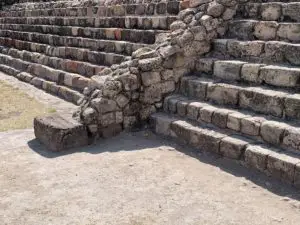 Archaeologists found a skeleton in the Red Temple buried with elaborate funerary offerings indicating elite status. The strange thing about the bones is that they have been dated to before the city was even built, predating it by a few centuries. Researchers believe that these are the mummified remains of a very important person, probably a very holy or noble individual, who was interred at this extremely important religious site for a reason. I kept wondering who this person could have been. A famous king or prophet revered throughout ancient Mexico for over a thousand years? No one knows and it’s a bit disheartening to think there is probably no way that we could know who this man was.
Archaeologists found a skeleton in the Red Temple buried with elaborate funerary offerings indicating elite status. The strange thing about the bones is that they have been dated to before the city was even built, predating it by a few centuries. Researchers believe that these are the mummified remains of a very important person, probably a very holy or noble individual, who was interred at this extremely important religious site for a reason. I kept wondering who this person could have been. A famous king or prophet revered throughout ancient Mexico for over a thousand years? No one knows and it’s a bit disheartening to think there is probably no way that we could know who this man was.
Before leaving the top of the pyramid Joel pointed out to me two square holes in the surface of the structure. He explained that they were used as chimneys of sorts, to burn ceremonial incense. The same type of incense was used in the pipes found in the few elite burials uncovered at Cañada. The sun beating down on us, we descended into the central plaza, up and down the stairs of the eastern perimeter of the House of the Thirteen Heavens and regrouped with our Mexico City friends. After hiking down the side of the large hill on which the ruins sat, our van met us at 3:15 and took us back to the visitor’s center along the familiar lumpy road. There is a lot more work to be done at Cañada de la Virgen. I couldn’t help thinking while driving away that one day this place will be known as a major archaeological site holding its own among the many more famous ones we all know today. For now, much of what is left to discover stays shrouded in speculation and mystery.
REFERENCES
I went there!
If you are ever in the San Miguel de Allende area feel free to contact the guide I used, Joel. He is excellent (Spanish speakers only): joelulg.s.m.a@gmail.com
